#european championships 1987
Text
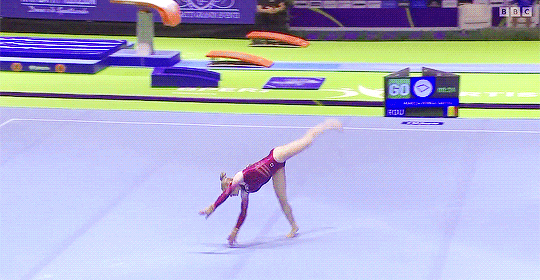

Sabrina Voinea (ROU) earns the silver medal in the floor exercise at the 2024 Rimini European Championships.
Her mother and coach, Camelia Voinea, won the silver medal in the same event, 37 years prior at the 1987 European Championships.
112 notes
·
View notes
Note
always am obsessed with motorsport champions that decide to run the number 1 plate vs those who’ve stuck with their number. because it reveals so much of each of their inner philosophies, whether they are deeply superstitious, or seek a tangible everyday proof of their victory, or concerned with branding/legacies, or trampling the inner critic that believed deep inside of them that they were cut out to be a champion. just so interesting to parse through possible motivations
you're so right anon!!
of course, a big part of it is historical context... you can't really disentangle the choice of whether to run the number one plate or not from the era within which they made said choice. until fairly recently, it was entirely the norm to pick the number one plate - and beyond that, even those who didn't finish in first tended to just adopt the number that represented the place they had finished in during the previous year's championship. so for instance in 1987, gardner was first, mamola second, lawson third, haslam fourth, macckenzie fifth, and so on. in 1988, gardner ran the number 1 plate... mamola 2, lawson 3, haslam 4, mackenzie 5, etc etc. the only champion who broke with tradition was british racer barry sheene (500cc champion in 1976 and 1977), known for being a rebel - and even the styling of his iconic number 7 was apparently a wee bit controversial:

sheene stuck with the 7 both after his formula 750 title and then after his two 500cc titles:


there's some ways in which sheene is kinda the prototype of the modern rider, and he was the first to reap the benefits of having a distinctive number associated with him

in the eighties and nineties, it was all back to number one plates - but then of course another rider decided to break with tradition
incidentally, the generally purported story for why valentino took the number 46 is that it was his father's number. if his autobiography is to be believed, the truth is a little different:
I am Valentino. Graziano chose that name for me because he wanted to honour the memory of his best friend, who drowned at sea, near Pesaro, at the age of eighteen. The fact that St Valentine's Day is just two days before my birthday was also a reason.
Number 46 originated when I raced minibikes. I was on a team with two kids from Gatteo a Mare, Marco and Maurizio Pagano. They are the brothers who lent me the Aprilia 125, which I used for my debut at Misano. All three of us had number 46 because we raced in three different categories. They too loved Japan and Japanese riders. One day we were mesmerised by a wild-card entrant at the Japanese Grand Prix who pulled off the most amazing tricks and seemed to have no fear whatsoever. He was number 46. And from that day on, so were we. For me, that lasted until I moved up to the Italian championship and, later, the European series. But when I finally made it to the world championship, I was asked to choose a number. I discovered that 46 was Graziano’s number when he won his first Grand Prix on a Morbidelli 250cc, back in 1979. Which was the year I was born. That’s why I decided that I, too, would be number 46. For me that number represents my career and, partly, my life. It certainly symbolises my massive, incredible, adventure.
so valentino was only the second premier class rider who stuck with his number. the norm of just following the previous year's standings to choose your number was kinda starting to die out in the late nineties anyway. by 2002, when valentino was defending his title for the first time, if you look down the list it's basically personal numbers all the way. still, valentino was the one to break tradition for champions - the first to do so in a couple of decades. valentino did also know sheene personally as a result of the link through his father, who was a friend of sheene's and had raced him:

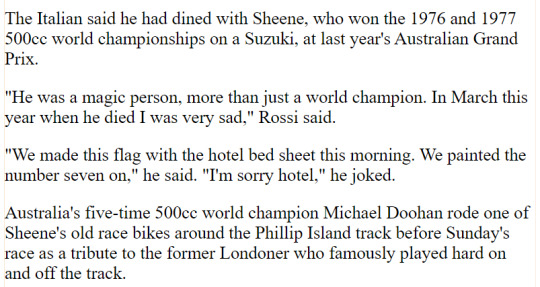

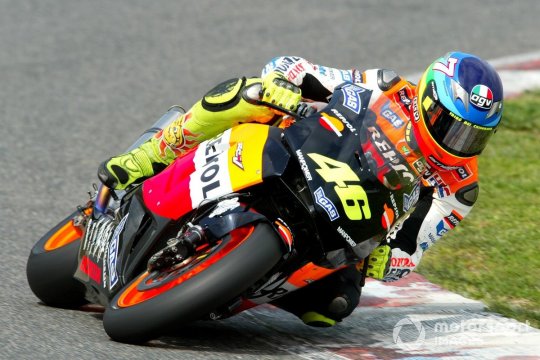
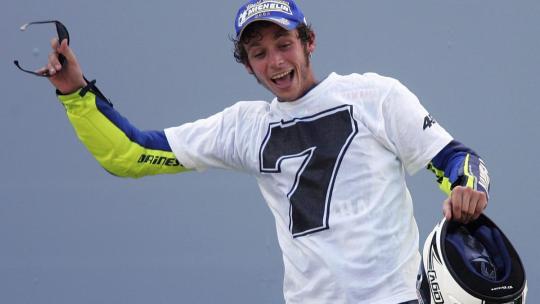
^valentino with sheene, valentino wearing a tribute helmet with the iconic '7' on it after sheene's passing (also with the rainbow helmet colours and the word 'pace' or 'peace' on the back during the 2003 invasion of iraq), and valentino's 2005 championship celebrations for his seventh title, his shirt again featuring sheene's seven
hayden didn't follow valentino's example and instead went for the number one plate in 2007. casey made the same choice for the 2008 season, then jorge in 2011... so for a hot moment it really did look like valentino had been just another blip. if anything, the trend was going the other way, with a couple of high profile instances of riders who hadn't won the title rejecting their established numbers:
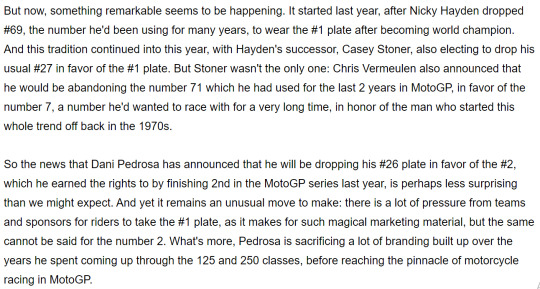
this particular trend didn't catch on, and from 2010 onward dani decided to just stick with the 26. because all the non-valentino aliens just couldn't stop faffing about with their numbers, 2010 is the only year in which all four aliens are actually concurrently running the numbers we most commonly associate them with

then, by 2012 apparently people were starting to get a bit superstitious about the number one plate. here, from an interview with casey:

the idea is that you can't defend the title if you're sporting the number one plate. which is true! in the 21st century, three guys chose the number one plate, and they defended their titles a grand total of zero times. one bloke stuck to his number, and he defended his title five out of seven times. so yes, it is technically correct that nobody with the number one plate had defended their title, though it is equally true that nobody not called valentino rossi had defended their title. I suppose we'll never know what the bigger factor was
anyways, if picking the number one plate was already a sure thing before, I reckon this sort of silly talk about 'jinxes' would have made casey even less likely to change his mind for 2012. not only is he stubborn, but he also takes an extremely dim view on superstitions
That race was the twelfth in a row that had been won by a rider not starting from pole, which was a new record. People were making a big deal about it and questioning whether, psychologically speaking, it wasn't a good thing to qualify on pole position at all. Maybe to the superstitious riders out there it had become an issue but I have never allowed myself to be affected by outside influences like that and I put an end to the stat by winning from pole in the next round at Laguna Seca in California.
It is amazing how many riders have superstitions, which to me are completely ridiculous. Pretty much every one of them has a little mascot or a lucky pair of undies that they once had a good result in and have been stuck with ever since (so to speak!). Superstition is basically just fear and as an athlete my view is that by allowing it to enter your mind you are effectively handing over control. My approach has always been to deliberately tackle it by doing things differently to the last time, just to make sure I don't get into a restrictive habit. Some riders look at their qualifying position and think, I never go well from fifth position, or arrive at a circuit thinking about past results there and say, 'I've never done well here before, it's not my favourite circuit.'
You have to be in the mindset that every day is a new day, a new set of circumstances. Every corner is different, every situation is different, and if you are not prepared to open your mind to that then you will always struggle more than necessary. You might have been through one particular corner a thousand times before but with a slight change in temperature, a new bike, a different tyre or a rider trying to pass you on the inside it becomes a completely different challenge and you have to be ready to deal with that.
given that casey is like, neurotically anti-superstition - well, he was probably always going to do the same thing as he did in 2008, but now he definitely would never just stick with his number. unlike jorge... who did change his mind, having run the number one plate in 2011 - but decided against making the switch in 2013. funnily enough, this did not help him defend the title. the eventual 2013 champion ended up also opting to stick with his number... and, well, marc's title defence went a little bit more smoothly. after jorge's 2015 title, he once again stuck to his 99, while marc has used the number 93 throughout his career. by the time you get to 2020, it's easy to have a warped perception of how common it is to keep your number. if you're born in, say, 1997 or later, you think it's basically the done thing to stick to your number, and it's really only a few outliers who use the number one plate. but even in the 21st century... it's really just valentino and marc who were doing it, plus jorge two out of three times. but between the two of them, they sure were winning enough of the titles to make it feel like the established norm
by this point, there really was a bit of a superstition about how the number one plate was 'cursed'. obviously, this wasn't actually a 'curse' as much as it was 'the dominant force in the sport in the noughties decided this number one plate thing wasn't for him and the dominant force in the 2010s who also happens to a massive fan of the other guy also decided not to make the switch either so that probably explains it'. it's not 'you won't defend your title if you're sporting the number one plate', it's 'you won't defend your title if your name isn't valentino rossi or marc marquez'. but obviously, sports drives people insane, so it was always going to be something that prompted a lot of speculation until someone finally managed to defend the plate
following his 2020 championship, mir didn't depart from the new tradition, with a suzuki video to announce his decision:

and fabio did likewise after his 2021 title:
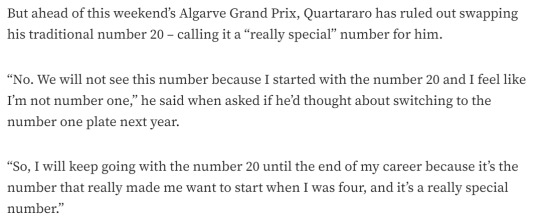
obviously, sticking to their numbers didn't actually help joan and fabio defend their titles, and after his 2022 championship it was pecco's turn to make the choice. pecco went about this in the most pecco way imaginable, with just a touch of public hand-wringing about the whole thing:


just as a quick reminder, before pecco there had been 28 premier class champions. five and two thirds decided against the number one plate - sheene, valentino, marc, joan, fabio, and jorge twice. "I have always been fascinated about riders with number one" describes something that until very recently had been completely normal. not even remotely noteworthy. cheers valentino
eventually, presumably after some extremely extensive introspection, pecco decided to go for the number one plate:


and also this:

and also this (look he's got a lot of thoughts on the matter, please allow him):

and talking about defending the number one:

pecco has continued talking about it sporadically since then. he's spoken about it in the context of defending his title, which as he points out he can only remember marc and valentino doing:

and then the pressure inherent to sporting that plate, from after he'd successfully completed his title defence:

hm. right. let's unpack
the thing about this whole 'running the number one plate' business is that in motogp, each rider's individual choice has to be read with that history in mind. for many years, this wasn't even really a question... it's just what you do when you win the title. sheene was the rebel, the one who decided to do things differently, who wanted to be associated with his very own number. and valentino, who himself knew sheene and was already attached to his own number and has always had a good sense for personal branding, decided to stick with 46. of course, valentino being valentino, he's inescapable enough within motogp that ever since he made that choice, every single champion after him has had to actively make a decision one way or another
so you've got jorge, who had used the number one plate in his title defence during his 250cc campaign in 2007 - and also used it in 2011 as motogp defending champion. he ended up changing his mind for his following two campaigns... remember, he only started using the number 99 in 2009 after his fractious split with his manager during 2008 (see more on numbers lore here). here was what he said about his decision in 2011:

versus his decision in 2015:

jorge in particular does of course have a bit of a complicated relationship with the numbers he's used during his career - and unsurprisingly he's clearly put quite a lot of thought into the whole matter. he's determined to still have the number 99 represent him in some way even in 2011, while also thinking about how he can integrate the number one into his initials - and since it's jorge, of course it's particularly important that his fans approve. he "won't forget" his 99, it was still on his leathers because it's still 'in his heart'... but he explains it by saying he has "earned the right", that it's a "unique opportunity". then, a few years later, his main cited reason for sticking with the number 99 is how it 'represents' him
very much a question of identity, then, something about how jorge made the choice to use the 99 and how it was an expression of liberation for him... he was tempted by the number one once and only once - a statement in itself, following on from jorge's title win in 2010 where the oppressively popular defending champion had been taken out of contention through injury. jorge says he's 'earned the right' because he feels like he deserves it and he wants to tell the world as much. did his failure to defend the title play into his decision not to run the plate again or did he just decide it wasn't really for him after all? did he realise he had grown so attached to the number 99, what it symbolised to him, that he didn't want to give it up again? or did he just realise it was better for personal branding?
last year, here's what casey had to say:

it's fun how the perception of it has changed so drastically, hasn't it? now it's kinda the brave decision to take it... and that's mainly the legacy of two blokes who happened to monopolise this century of racing and decided to make their numbers their own (you may have noticed that there's considerably less material out there on why they made the choice they did). it's gone from something that you just sort of did automatically to something that puts a bit of a target on your back. because that's the subtext, right - everyone wants to 'take the number one plate'... which obviously they do anyway, but all this talk of curses and jinxes attempts to give it a bit of extra weight. is it presumptuous to take that number? valentino and marc made the call to stick to their numbers - and years later it's become a statement to deviate from that path. in that fabio quote above, in context he's really just trying to say he feels like he's the number 20 and nothing other than that - but "I feel like I'm not number one" is still a teensy bit loaded. how did marc's injury affect the choice made by those in his absence?
casey is unsurprisingly very firm on the whole thing, "you are world champion and you should be wearing number one". as if doing anything else is shying away from this duty. defending the title is another "challenge" that he says he likes - almost like a way of putting extra pressure on himself. though in a different interview, casey also says this:

just a number after all, then? it's also interesting how they frame it in different ways, isn't it? for casey it's "recognition" of an achievement, for jorge it's something you've "earned"... and for pecco, it's something you "need to respect". it's about something that puts "pressure" on you... perhaps that's partly because so much of the discourse about the number one plate has become about defending the title (or failing to do so), but pecco discusses it more as a responsibility than something he deserves. you can tell that it's clearly preoccupied him for a while - it's something he's "fascinated" by, he's "admired" people who have done it, he's "always loved it". for both casey and pecco, part of it seems to be about respecting the history of all the blokes who have used the number in the past, like it's an act that pays tribute to that heritage. you'd think this shouldn't have been such a tough choice in the first place, wouldn't you? goes to show how much of a break with tradition it's become - tradition, of course, that was really started by pecco's own mentor. would it be that surprising if that's part of the reason for the reticence? and, at the same time, would it be that surprising that his mentor's long shadow might make him feel like he needs that big and bold number one? what does pecco think it's saying that he went a different way? all this public hand-wringing just because he's breaking a trend
for jorge, the number one plate was a public declaration that he'd made it, naysayers be damned. to pecco, "the number one plate means you need to demonstrate you are number one". it's like giving yourself a point to prove... is it mainly a matter of pride or giving yourself something to live up to? both of them go to great pains to stress their continued attachment to their original number, how they're continuing to integrate it into all their cute designs... and that is something that has changed pretty definitively - not entirely as a result of valentino, but around the same time as valentino emerged as the figurehead of the sport, and he's certainly a big part of it. even the riders who go with the number one still want to have their number and to be known by it. the numbers have become such an integral part of branding and rider identity that riders want to make clear how important they are to them, whether they stick with the number as defending champions or not
at the same time, the fact that taking the number one plate has been de-normalised means that this decision places extra focus on the challenge of defending the title. pecco might not frame his choice in opposition to valentino and marc's to keep their numbers, but he does repeatedly link it to how they alone had been able to win successive titles. for him, then, it becomes an indirect way of living up to a legacy - counterintuitively by doing the opposite of what they did. "since I remember, was just marc and vale have repeated the title" “I thought about it many times this season in all the races we were struggling that the only two riders able to win two years in a row were marc and valentino"... that's what he's trying to live up to, this simultaneous source of inspiration and insecurity. are you lacking confidence if you need to see the number one to believe yourself that you are the number one? or is it conversely shying away from something you have rightfully earned if you can't bring yourself to take the plate? is it an expression of ego if you think your personal number is more meaningful than the number one could ever be? personal branding decisions aside, wouldn't manufacturers much rather you display the number one plate proudly on their bikes?
kind of remarkable, isn't it? it should be such a simple choice... and yet. not only is it now a question of branding and identity, but within motogp it's also become one of how you relate to the legacy of two specific riders. maybe it'll gradually become more common again to take the plate - after all, the curse has now been broken. or maybe it will be the source of much hand-wringing forevermore... we shall see. we shall see
#personally I'd always keep my own number lol. but I also think pecco specifically made a good call#though maybe it would've helped to do a little bit less public introspection and hand wringing and soul searching#poor little ferret wants a number one on his bike. needs to write essays justifying it. buddy it's fine who cares#batsplat responds#//#brr brr#does it bother anyone else that valentino doesn't actually use a continental number seven? no? just me?#some of sheene's 7s didn't have the dash. which. there may be a good reason for this but it doesn't quite feel like ideal branding-wise#taking a massive sharpie to valentino's title winning shirt#incidentally schwantz generally stuck to his 34 until he won the title. thought it interrupted the flow too much to mention it but#current tag
55 notes
·
View notes
Text
Top 20 F1 races that are widely considered as some of the greatest of all time, based on their historical significance, drama, and excitement:
1. 1979 French Grand Prix - this race is famous for a memorable battle between Gilles Villeneuve and René Arnoux, who exchanged positions multiple times in a thrilling duel.
2. 1984 Monaco Grand Prix - regarded as one of the greatest drives in F1 history, Ayrton Senna drove a masterful race in wet conditions to secure his first Monaco win.
3. 1985 European Grand Prix - a dramatic race that saw Brazilian driver Ayrton Senna and French driver Alain Prost battling for the championship. Senna emerged victorious after a controversial collision with Prost.
4. 1986 Mexican Grand Prix - a classic race that saw Nigel Mansell in the Williams-Honda chasing down Ayrton Senna's Lotus-Honda in the closing laps, with Mansell setting the fastest lap on the final lap of the race.
5. 1987 British Grand Prix - a thrilling race that saw Nigel Mansell win his home Grand Prix in front of an ecstatic crowd after a tense battle with his teammate, Nelson Piquet.
6. 1991 Australian Grand Prix - a dramatic race that saw Ayrton Senna and Nigel Mansell battle for the championship in a rain-soaked racethat was eventually red-flagged due to weather conditions. Senna was declared the winner, securing his third championship.
7. 1993 European Grand Prix - a race remembered for Ayrton Senna's stunning opening lap, where he went from fifth to first in just a few corners in the rain.
8. 1994 Australian Grand Prix - a race that marked the end of the tragic 1994 season, which saw the deaths of Ayrton Senna and Roland Ratzenberger. Damon Hill won the race and the championship, becoming the first son of a world champion to win the title himself.
9. 1996 Monaco Grand Prix - a wet race that saw Olivier Panis score his first and only F1 victory after the leading cars of Michael Schumacher, Damon Hill, and Jean Alesi all retired.
10. 1998 Belgian Grand Prix - a chaotic race that saw a multi-car pile-up at the start and a dramatic last-lap collision between Michael Schumacher and David Coulthard, with Schumacher confronting Coulthard on the track after the incident.
11. 2000 Japanese Grand Prix - a title-deciding race that saw Michael Schumacher win his first championship with Ferrari after a tense battle with Mika Hakkinen.
12. 2003 Brazilian Grand Prix - a race that saw F1 legend Michael Schumacher and up-and-coming driver Kimi Raikkonen battle it out for the win ina thrilling race that went down to the wire.
13. 2005 Japanese Grand Prix - a race that saw Fernando Alonso secure his first championship in a dramatic race that saw multiple lead changes and a late-race charge from rival Kimi Raikkonen.
14. 2006 Brazilian Grand Prix - a race that marked the end of Michael Schumacher's career, with a tense battle between the German and Fernando Alonso for the championship. Alonso ultimately won the title, while Schumacher finished his F1 career with a podium finish.
15. 2008 Brazilian Grand Prix - a race that saw Lewis Hamilton secure his first championship in a dramatic final lap, passing Timo Glock in the closing stages to finish fifth and secure the title by a single point.
16. 2011 Canadian Grand Prix - a race that saw Jenson Button score a stunning victory after battling back from last place, with multiple safety car periods and a red flag adding to the drama.
17. 2012 Brazilian Grand Prix - a race that saw Sebastian Vettel secure his third championship in a tense battle with Fernando Alonso, with Vettel finishing sixth to secure the title by just three points.
18. 2014 Bahrain Grand Prix - a race that saw Lewis Hamilton and Nico Rosberg battle it out for the win in a thrilling wheel-to-wheel battle that went down to the wire, with Hamilton ultimately emerging as the victor.
19. 2016 Brazilian Grand Prix - a wet race that saw MaxVerstappen and Lewis Hamilton battle it out for the win in a dramatic race that saw multiple lead changes and a red flag period. Verstappen ultimately emerged as the victor.
20. 2019 German Grand Prix - a race that saw Max Verstappen secure a stunning victory in wet and treacherous conditions, with multiple drivers crashing out and a dramatic fight for the podium positions.
These races are considered among the greatest of all time due to their historical significance, the drama and excitement they provided, and the memorable moments and battles they produced. Each of these races had a unique story and left a lasting impression on F1 fans and the sport as a whole.
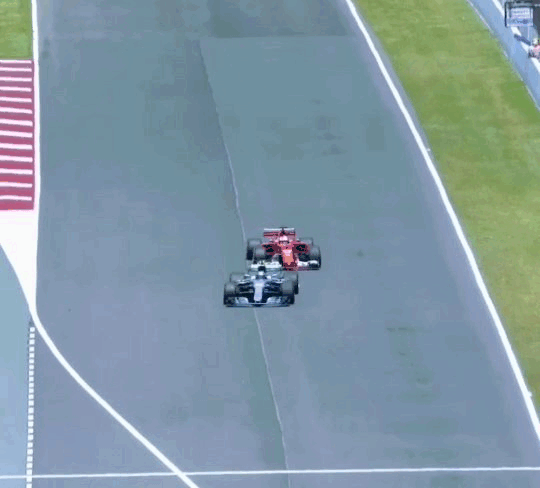
31 notes
·
View notes
Photo

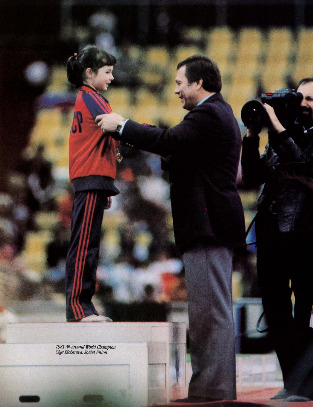


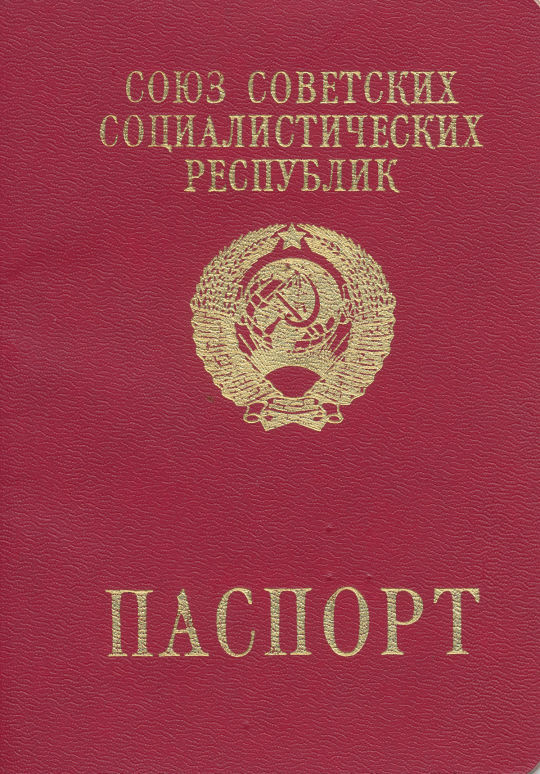




A non-exhaustive list of gymnasts whose ages are known to be falsified.
“Dick does she look 14 years old to you? [...] I tell you we have a story going around the gymnastics community that is pretty traditional that when a young Romanian girl is asked her age she looks to her coach for the answer.” --Bart Conner, 1985 American Cup
Since Wikipedia can’t be trusted to be right for a lot of details of gymnasts careers...
Olga Bicherova
Born in either 1967 or 1968, during Bicherova’s elite career the age requirement was that you had to turn 15 in the year of competition. Either birthdate would have made her too young for the 1981 World Championships where she won two gold medals, one in the all around and one with the team. If you take the 1967 birthdate she could have been age eligible for the 1982 World Cup where she won 5 medals, 3 of them gold except that one of the requirements of the World Cup at that time was previous participation in the World Championships. [In fairness to Bicherova the above picture is slightly mean of me to use as she never grew very tall.]
Ecaterina Szabo
Born in 1968, during Szabo’s elite career the age requirement was to turn 15 in the year of competition meaning her first year of senior eligibility should have been 1983 and 1983 is when her first major titles occurred. Except she was competing as a senior in 1982 winning a number of international invitationals (which she may have been eligible for anyway because juniors and seniors often competed together at those). It’s unclear to me why her birthdate was changed though it might have simply been something that happened when the government changed her name to hide her Hungarian ethnicity. Szabo’s first language is Hungarian and she was born in Transylvania as Szabó Katalin. She still goes by Katalin in her private life. She was of age during the 1984 Olympic Games and the 1983 World Championships
Olga Mostepanova
Born in 1970, during Mostepanova’s elite career the age requirement was to turn 15 in the year of competition (or 14 for the World Championship that qualified for the Olympics). She has said herself that while she was competing her passport was wrong by “years”. By the accounts as I understand them her first senior year should have been 1985. Mostepanova was the top Soviet gymnast in 1984 winning the alternative games held for countries that boycotted the 1984 Olympic Games (and the reality of her age falsification makes playing ‘What if?’ for who should have won the 1984 Olympics awkward). Aside from her 5 Friendship Games gold medals, she would have also been age ineligible for the 1983 World Championships where she won 4 medals, 2 gold (team and beam) and 2 silver (all around and floor).
Oksana Omelianchik
Born on January 2, 1970, during Omelianchik’s elite career the age requirement was to be turn 15 in the year of competition and her first year of eligability was 1985. None of Omelianchik’s elite career honors are tainted however she says at one point she was given a passport with her birthdate shifted by a week (which would have made her able to compete in the 1984 Olympic Games).
Daniela Silivaș
Born in 1972, during Silivaș’ elite career the age requirement was that you turn 15 in the year of competition meaning her first year as a senior elite should have been 1987. In 1985 she won a European bronze medal on beam, a World Championship gold medal on beam and a silver with the team. She also won 3 medals at the 1986 World Cup. She was of age for the 1988 Olympic Games
Kim Gwang-suk
Only the universe knows what year Kim Gwang-suk was actually born. She was listed as 15 years old for three consecutive years by the North Korean government from 1989-1991, and then 17 years old at the 1992 Olympic Games. She may have been as young as 11 when she competed in the 1989 World Championships. In 1991 she won the World Championship gold on the uneven bars and at least one of her birth years means she might have been age eligible for that competition (which may be why FIG was reluctant to take away that medal, officially they decided that as she wasn’t personally involved in the fraud she could keep it). The North Korean team was banned from the 1993 World Championships for the sloppy fraud.
Alexandra Marinescu
Born in 1982, the age requirements changed in the middle of Marinescu’s elite career. For the 1996 Olympic Gams you had to turn 15 in the year of competition and starting in 1997 you had to turn 16. The Romanian state issued her a passport giving her birthdate as 1981 and it is worth noting that this was the post revolution Romanian government. She competed at 1995 Worlds, 1996 Worlds, and the 1996 Olympic Games with a stated birthdate that would make her just old enough to compete in those competitions. In fact she was younger than both Dominique Moceanu and Vanessa Atler. At no point during her entire elite career which lasted 3 years was Marinescu of age. She has 3 World medals (2 gold for the team in 1995 and 1997, 1 silver on beam from 1996), and one Olympic medal (bronze in the team from 1996). The FIG database still lists her incorrect birth year and the Romanian gymnastics federation claims that she is lying about the age falsification (as well as other abuses she has been outspoken about).
Dong Fangxiao
Born sometime in January of 1986 (the exact day is still disputed), during Dong’s elite career the age requirement was to turn 16 in the year of competition. Her first year of senior competition should have been 2001 but she competed at the 1999 World Championships under the rule at the time that if you are eligible for the Olympic Games you cold compete at the World Championships the previous year. She won a bronze medal at both 1999 Worlds and the 2000 Olympics with the team. In 2008 she applied to be a technical official at the Beijing Olympic Games she listed her true birthdate instead of the 1983 birthday under which she had competed. An investigation of the case resulted in both medals being stripped.
Hong Su-jong
At different competitions during her career Hong Su-jong was entered with a birth year of 1985, 1986, and 1989. At some of these competitions she was entered with a different birth year as her twin sister Hong Un-jong (Olympic and World Champion who has never herself been implicated in age falsification). Hong Su-jong’s most significant medal was the 2007 World silver on vault which she is believed to be of age for but she competed at the 2004 Olympic Games with the 1985 birthdate and for that competition she was too young. Hong Su-jong was eventually banned permanently from competition and North Korea was banned until October 2012 meaning that her sister was unable to defend her 2008 Olympic vault gold.
You may notice that He Kexin is not on this list...
During (and after) the 2008 Olympic Games questions were raised about two time Olympic Gold medalist He Kexin’s age (as well as that of several of her team mates). Unlike all of the above cases where either inconsistent age information was entered at official FIG competitions or the gymnast themselves have stated that their birth year was changed, He’s birthdate has always been consistent in FIG documents and she herself has always denied falsification. Her age was listed as earlier in entries for some domestic meets and that was reported by foreign press as evidence that she was too young. This ignores the fact that age falsification (in both directions up and down) was common by city and provincial teams in China to enter age bracketed competitions and that is what may have been going on. Either way these competitions are not governed by the FIG so the inconsistent birth information at them was not their problem. I am generally agnostic about He’s birth year. There is strong circumstantial evidence to suggest that her age was changed (that doesn’t have to do with domestic competition forms or her appearance) however I understand why the FIG investigation decided that there was not enough evidence for them to act.
Sooooo the only people punished for age falsification have been Asians. That’s kind of racist isn’t it?
Two things can be true at the same time. Yes it is highly suspicious that only North Korea and China have been punished for this while there are documented cases of European federations also doing this. However I think it’s important to note that these cases are not all the same. North Korea was punished for providing inconsistent birthdates for the same gymnast at competitions. The evidence of the offense was right there in FIG’s paperwork. China was punished when Dong applied to be an official with FIG giving an inconsistent birth year.
All of these other cases involve gymnasts whose paperwork was consistent during their careers.
The fact that FIG is only accepts that level of proof and unwilling to accept (especially in Marinescu’s case) the gymnasts own statements about their birth year certainly doesn’t make them look like they are particularly interested in punishing this kind of cheating unless absolutely forced to. I would offer the counter point that FIG is not the police and they do not have the ability to determine if there is something else going on with such public statements and they often came out well after the standard 10 year statute of limitation for stripping medals (except in the case of Marinescu). Some have suggested that FIG was reluctant to act on Marinescu’s statements because stripping Romania of those medals would promote China who was also age cheating at the time. I don’t think you have to go to that place when the answer is just as likely that FIG has a very narrow standard of proof for revoking medals on the basis of age falsification and has even erred on the side of allowing the gymnast (Kim Gwang-suk) to keep a medal won while clearly under age.
Are FIG officials racist against Asians? There is a lot of evidence for that.
Has FIG only punished Asian nations for age falsification? Yes. But it’s more a case that North Korea is really bad at this and the Dong case has fairly unique circumstances.
#gymnastics#olga bicherova#daniela silivas#he kexin#hong un-jong#hong su-jong#alexandra marinescu#olga mostepanova#oksana omelianchik#ecaterina szabo#kim gwang-suk
56 notes
·
View notes
Text

A princess at seventy
Stamp Collector | Published 20 July 2020
HRH Princess Anne was born at Clarence House, London, on 15 August 1950, and Jersey will issue a set of stamps and a miniature sheet to celebrate her seventieth birthday on 15 August. The only daughter of HM Queen Elizabeth II and Prince Philip, Duke of Edinburgh, Princess Anne was created the Princess Royal in June 1987, a title that is traditionally carried by the British monarch’s oldest daughter and held for life.
Princess Anne began undertaking public engagements at the young age of eighteen. Since then she has built up a working relationship with many organisations and charities across the Commonwealth. Dedicated to many causes, and a sports enthusiast, HRH The Princess Royal has one of the busiest working schedules of all the Royal family members.
Princess Anne is involved with over 300 charities, organisations and military regiments in the UK and overseas, and she devotes a large part of her working life to official engagements and visits. Although dedicated to many charities and causes, The Princess has been the president of Save the Children UK since 1970 and to this day continues in her efforts for this cause.
From an early age, Princess Anne had a keen interest in horsemanship and progressed through the years to the highest level of equestrian competition. Her love of horses and eager sportsmanship has been evident throughout her life. In 1971, Princess Anne won the individual European Championship and was a member of the British three-day eventing team at the Montreal Olympics in 1976.

Princess Anne went on to become a British member of the International Olympic Committee, a position that she was able to take up with great insight of the Olympics. In 2012, London hosted the Olympic Games with The Princess Royal taking part in the successful bid to host the event and also as a member of the London Organising Committee.
Six stamps feature iconic photographs, which show HRH Princess Anne throughout the decades preceding her seventieth birthday. The 54p value shows HRH Princess Anne attending St. John’s Ambulance Cadet Review in Hyde Park on 7 July 1972. On the 70p HRH Princess Anne is pictured at her home Gatcombe Park, on the occasion of her sixtieth birthday in 2010.
The princess is pictured competing at the Olympic Games in 1976 with her horse Goodwill on the 84p stamp; and the 88p value shows her at the first day of Royal Ascot on 18 June 2019.
The £1.05 stamp shows HRH Princess Anne pictured at the Olympic Games handover ceremony at the Panathenaic Stadium, Athens, Greece on 17 May 2012; and the £1.18 sees The Princess Royal, Colonel of The Blues and Royals, during the Trooping the Colour in London on 12 June 1999.
The Miniature Sheet depicts HRH Princess Anne riding her horse, Goodwill, during the show-jumping section of the European Eventing Championship at Luhmühlen, in September 1975.
49 notes
·
View notes
Text
TMNT 2012 characters in Halloween costumes
Happy Halloween everyone! To celebrate, I decided to share my vision of what costumes some of the TMNT 2012 characters would wear for Halloween. This would also be set after Trick or Treat Tussle, the Halloween themed video game that had Leo as Captain Ryan, Donnie as what I believe is a troubadour (Mickey Mouse Three Musketeers reference anyone), Mikey as SpongeBob, April as a ninja turtle, and Raph as the famous fairy princess.
So, this is what I got!
Leonardo as a masked warrior/swordsman (inspired by our lovely blue dragon warrior here)

This was one costume idea I struggled with the most, but I ultimately decided on this remembering Shin-Ah from Yona of the Dawn. I just think it'd be cool to see Leo dress up in something related to his combat skills while still looking like a badass/dork. Complete with a bathrobe, some of his usual gear, and a paper mache mask, Leo is ready for Halloween.
Donatello as a scientist
This was one of the first ideas I had for Donnie, and I feel as though it's perfect. The overall inspiration is from Donnie's design in tigerfog's 2003 fan comic, NMT Gaiden. I just really liked the eyepiece Don wore, complete with a lab coat. Add in some protect gloves and liquid filled bombs (filled with dyed water and soda!) to the equation, and you get Donnie's costume.
Raphael as a body builder (inspired by Doug from 50 First Dates)

What's funnier than Raph deciding to dress as a strongman? Raph dressing up like Sean Astin from 50 First Dates. The outfit itself is RIDICULOUS, but I do see Raph wearing that mesh shirt. 🤣 Add shorts, gloves, the red baseball cap, and yes, even sunglasses, and you get Raph as Doug Whitmore. Oh, and make sure he gets some Reese's in his treat or treat bag.
Michaelangelo as Ice Cream Kitty
For quite a while, I've been stuck on what costume Mikey would wear. Like... there are SO MANY GOOD IDEAS. I turned to Instagram and asked peeps for suggestions. I chose his favorite ice cream cat, because he'd go all out with face/body paint, the classic cat ears, and even make a bowl to wear. I just think that's overall, a very Mikey costume that isn't a character from another existing franchise.
April as a simulacrum news reporter
The overall inspiration comes from BOTH a judge's costume I saw in Halloween Baking Championship (a ghostly news reporter) and that April in the 1987 series is a news reporter! I didn't want to go with the jumpsuit, so April would be wearing something a bit dressier like what female news reporters typically wear. I then thought she'd be a different creature as opposed to being a human news reporter. I settled with a simulacrum, or "frankenmonster", because the thought of April having the same mint green skin with scars like Sally from Nightmare Before Christmas is a good Halloween look (especially with her naturally gorgeous red hair),
Casey as a serial killer
Like in the Halloween arc, this is just an excuse for Casey to dress up in his usual vigilante gear. However, it's Halloween, so he has to be a bit more creative. So, Jones would whip out some older, dirtier, and wrecked gear like a broken mask, a baseball bat (taking a bit of inspo from Negan from Walking Dead), and red paint. Lots and LOTS of red paint.
Karai as a masked vampiress
I remembered a long time ago, someone compared Karai with her snake eyes/fangs to a vampire when her mutation first happened, and honestly, I can see it! That brought me to come up with this idea for Karai's costume. Imagine it being an old European/gothic look on her with a black dress with frills, a beautifully decorated black mask, and gloves. Safe to say that Shini has likely helped Karai pick out the right clothes for the look, and even do her hair and makeup.
Shinigami as a cat witch (inspired by Blair from Soul Eater)

This is one I just thought of as a fun idea. In Soul Eater, Blair is a recurring character who appears to be a witch girl with cat ears, but she's actually a real cat! Because Shini is a witch and cats are basically her spirit animal, it just makes sense for our underrated Foot Clan witch to go that costume route. Shini might as well be capable of casting a spell to give herself cat ears underneath a witch hat.
Slash as Raphael
This was just a cute idea that came to me. Slash wouldn't do much, but since he was Raph's owner before his mutation, I just thought it'd be sweet if Slash went as him for Halloween. All he really needs is a red mask and a giant pair of Sai.
Leatherhead as Frankenstein's monster
This one was from a suggestion by @fabuloustrash05 (out of a few options), but I think this one was the best fit for Leatherhead, because of the similarities between the two. He probably wouldn't be able to dress in costume, but that's why doing makeup is an option. I can see Mikey giving his gator friend some fake stitches/scars and neck bolts to make him the coolest franken-gator ever!
Mondo Gecko as an 80s rock star
The amount of times our skater gecko has this rocker guy personality, from using his skateboard as an air guitar and even his speech pattern, I just think this would be a fun costume idea for Mondo. Also would mentioning that his voice actor Robbie Rist is a musician.
Mona Lisa as Morticia Addams
This is something I borrowed from FabTrash, but for those who don't know, Sean Astin's father was Gomez in the live action Addams Family show from the mid 1960s. Since I didn't think to have Raph dress as Gomez, I'm making up for it by having his girlfriend Mona dress as the beautiful hag Morticia! Well, with just the iconic black dress and a bit of dark makeup. But just because Raph isn't Gomez in this list of characters in Halloween costumes doesn't mean he won't wear a Gomez costume for Mona.
Renet Tilley as Michelangelo
I always saw Renet as a big Ninja Turtles fanatic, and because her close bond with Mikey, it's beyond safe to say she likes him the most. I just think it's cute that Renet would wear a ninja turtle costume like April did in the Trick or Treat Tussle game, and she'd choose Mikey of course.
BONUS: Alex as a Dragon
I didn't want to leave out my Ally-boy on this. The idea was suggested by @xartisticmdx, so a dragon is the best one for Alex. He'd wear one of those pull-over masks with the mouth open that looks like a dragon's head and a tail to match. I would also think Mikey uses darker green body paint to give Alex scales, and even tape the wings and spine spikes onto his shell.
23 notes
·
View notes
Photo




Happy Birthday Scottish rally driver Jimmy McRae born 28th October 1943.
He might be most well known as father to the late Colin McRae but regardless of his sons’ subsequent success, Jimmy McRae remains the most successful British Rally Championship competitor of all time – bar none.
Jimmy won the British Rally Championship title five times in 1981, 1982, 1984, 1987 and 1988 which as of 2020 still stands. In the European Rally Championship for drivers, he was runner-up in 1982, while his highest placing in the World Rally Championship was fifteenth in 1983.
Jimmy McRae was born in Lanark, where he developed a plumbing business and started to race relatively late, at the age of 31. His first rally cars in 1974 were Ford Cortina MkI and Ford Escort MkI, before he switched to Vauxhall Magnum Coupe in 1975.
He and his wife Margaret had three sons, Colin, Alister and Stuart. Both Colin and Alister McRae were World Rally Championship drivers. McRae’s brother-in-law Hugh “Shug” Steele is also a former rally driver.
The 2022 annual McRae Rally Challenge first ran, in honour of Jimmy’s son Colin, back in 2015 saw three generations of the McRae dynasty race, which must be a first, Jimmy’s grandson, Max, the 18 year old beat his dad, Alistair, 51 and grandfather Jimmy, who turns 79 today.
Are we about to see another McRae light up the world of motor racing, proung grandad Jimmy says; “ he’s proving to be very successful and just driving to his ability,”
“He’s had one or two wee problems and sometimes when you have a problem you can get overexcited and try too much on the next stage but he seems to just drive at his speed, so I’m very, very proud of him.”
4 notes
·
View notes
Text
BMW M30 E30: Timeless Elegance - How It Became a Legendary Icon

The BMW M3 E30 is a legendary sports car known for its great design and powerful features.
It has a strong engine and advanced tech.
This makes it a favorite among car lovers around the world.
Its limited number and success in motorsport increase its value.
The BMW M3 E30 signifies more than just a car.
It stands for BMW's dedication to making amazing cars.
Origins: BMW's Quest for Motorsport Domination
For nearly 100 years, BMW has been a leader in cars.
It opened BMW M Motorsports in 1972 and started winning in European races with the BMW 3.0 CSL in 1973. They succeeded, showing they were ready for more.
BMW quietly planned to race even harder for almost ten years.
Then, there were whispers in racing circles. People talked about something big coming from BMW.
Founding of BMW M Motorsports Division
In April 1980, the big news hit. BMW M Motorsports would join the 1983 Formula 1 World Championship.
They won, thanks to Nelson Piquet and the Brabham-BMW.
Early Racing Success with BMW 3.0 CSL
In 1973, the BMW 3.0 CSL started winning titles.
This success was a hint of the great things BMW would do in racing.
They kept quiet about their big plans for almost a decade.
Rumors of a New BMW Powerhouse
But, BMW had more in store. With a strong history, BMW M Motorsports worked on a secret car in the early 1980s.
This car would be the amazing BMW M3.
Birth of the BMW M3 E30
The BMW M3 E30 was first seen at the 1985 Frankfurt Motor Show. It brought a bold look and a sleek design.
With a similar look to the M4, the M3 had a fixed back wing and striking wheel arches.
It carried a strong 2.3-liter engine, making almost 200 horsepower and reaching a top speed of 147 MPH.
Aggressive Visuals and Aerodynamic Design
The M3 E30 stood out with its sharp lines compared to the 3 Series. It had a fixed rear wing and bold wheel arches.
These design choices made it look ready for the race track.
The careful design work also helped in its top-level performance on any road.
Powerful 2.3-liter S14 Inline-Four Engine
The BMW M3 E30 had a 2.3-liter inline-four engine.
It could generate almost 200 horsepower.
This set it on the path for thrilling performance and a high speed of 147 MPH.
This engine showcased BMW's focus on creating outstanding cars for driving lovers.
Homologation and Group A Racing Requirements
Since 1972, BMW M Motorsports aimed to compete with top racecars in Europe and beyond.
They focused on creating cars for the BMW M3 E30 Group A racing series.
These vehicles needed to be thrilling to race with, yet comfortable for daily use.
The International Automobile Federation set tough rules for the cars.
For instance, the BMW M3 E30 had to be designed especially for racing. It also had to meet certain targets, like selling 5,000 cars in its first year.
At the same time, it had to fit within certain weight, power, and BMW M3 E30 technology boundaries.
The BMW M3 E30 met these rules perfectly.
It weighed 2,568 pounds and its engine was only 140.5 cubic inches.
Initially, the E30 M3 showed impressive power. Its 140.5 cu-in. engine made 197 Horsepower and 177 Pound-feet of Torque.
It used a 5-speed manual gearbox and was rear-wheel-drive.
Power and Technology Restrictions
To comply with the BMW M3 E30 Group A regulations, BMW needed to follow strict rules.
These were about BMW M3 E30's power output and tech limits.
The rules also dealt with how big the engine could be.
They even covered the weight and how air flowed around the car. This was all to make the M3 a worthy competitor in touring car races.
BMW E30: Lightweight and Nimble
The BMW M3 E30 was unique in the racecar scene.
It was not just any car but stood its ground with its unique design and weight.
The M3 weighed 2,568 pounds, much less than its rivals like the 1987 Audi Quattro which weighed 3,880 pounds.
This was because the M3 didn't have some features, such as a sunroof, power seats, and air conditioning, to keep its weight down.
Absence of Luxury Features
The BMW M3 E30 was built for top performance rather than luxury.
By skipping heavy, non-essential parts, the car became more agile and quick on the road.
This choice in design is what made the M3 stand out, letting it handle like a dream.
Use of Lightweight Materials
BMW used advanced materials in the M3 E30 like aluminum, plastic, and lightweight glass.
These materials helped the car stay light and handle well. This focus on light parts is why the E30 M3 was a blast to drive.
Dominating the Racetracks
BMW M was crystal clear about its mission with the BMW M3 E30.
They joined the 1987 World Touring Car Championship to win. And they did just that. After 11 races, the BMW M3 E30 showed its power.
It left a strong message for all competitors: BMW M came to race and win.
Success at the 1987 World Touring Car Championship
In the Driver's Championship, M3's dominated.
Roberto Ravaglia topped the leaderboard with 269 points. At the Entrants Championship, M3's almost grabbed the top position.
They scored 253 points, just behind a Ford No. 7 with 249 points.
Impressive Driver's Championship Results
The BMW M3 E30 is truly legendary. It won a staggering 1436 first-place titles out of 1,500 races.
This model showed amazing motorsport performance.
It often outperformed competitors like Alfa Romeo and Ford Cosworth in European races.
BMW E30: Timeless Elegance and Performance

BMW E30: Timeless Elegance and Performance by autoambiente in autoambiente.com
The BMW M3 E30's might have seemed boxy at first, but it proved itself in the real world.
Its aerodynamic design was a hit on both the track and normal roads.
With a drag coefficient of 0.32, it beat the 1987 Audi Quattro's 0.36. This shows BMW really focused on both speed and handling.
Its design helped cut down air resistance and pushed the car down, giving it more grip.
This meant the M3 could perform better, turn sharper, and stay stable at high speeds.
Competitive Pricing and Mass-Market Appeal
Any car company wants to make money by finding the right buyers and making their cars desirable and affordable.
BMW M went all out with the M3 E30, aiming for a blend of a sporty look and practical features that everyone could enjoy without breaking the bank.
Despite its sporty nature, the M3 E30 was competitively priced at about $30,000, standing up against rivals like the Audi Quattro and the Mercedes-Benz 190E. This smart pricing helped position the M3 E30 well in the market.
Racecar-Inspired Interior
Many early high-performance cars put all their effort into speed, leaving the insides looking sparse.
But the BMW M group made the M3 E30's interior special. They added many cool features for the driver.
The M3 E30 came with a roof check panel, Recaro seats, a sunroof, and even an oil-life gauge.
These extras made driving the M3 E30 a real pleasure.
BMW E30: Iconic Styling and Pop Culture Influence
Recognizable Boxy Design and Styling
The BMW M3 E30 stands out because of its unique design. It looks different from the regular BMW 3 Series.
The M3 boasts a boxy and aggressive shape, featuring a fixed rear wing and distinct wheel arches.
This design highlights its fierce, race-ready appearance, setting it apart on the roads, tracks, and car shows worldwide. Covered by elegant sheet metal, the M3 E30 almost turns into a form of modern art.
Appearances in Music and Movies
The BMW M3 E30 goes beyond being just a car.
It has become a star in the music and film scenes. The first high-performance car from the M Division found fame on music album covers.
It appeared in works by artists like Frank Ocean and Tyler the Creator.
Furthermore, it played key roles in films like "Paid in Full" and "Ocean's 8". These appearances showcase the M3 E30's lasting appeal in Hollywood and pop culture.
Limited Production and High Demand
The BMW E30 M3 is a legendary car, partly because not many were made.
In the US, fewer than 8,000 models arrived over five years. This makes the E30 M3 very exclusive and its value has been going up over time in the classic car market.
The E30 M3 is rare and its production numbers are small. This is why it's worth so much.
Enthusiast Auto sold these cars at higher prices, making them more expensive. After 25 years, the E30 M3 may get even pricier as it becomes a true classic.
"The E30 M3 has demonstrated strong financial value appreciation due to its homologation special status and racing heritage."
The E30 M3 had several special editions like the Sport Evolution and others. This has made them scarce and desired by collectors.
Its racing history and exclusivity have made the E30 M3 a prized possession among both fans and collectors.
Conclusion
The BMW M3 E30 stands out as a key player in the sports car world. It is loved for its classic look, thrilling speed, and top-notch tech.
Car fans still find it amazing today. The M3 E30 shows how dedicated BMW is to make awesome cars that people enjoy.
It's a true legend in the sports car scene.
This BMW left its mark, for sure.
Although not many were made, its value climbs high in the classic car scene.
The car pops up in music and movies, making it dear to fans all over. The M3 E30 truly shines as an automotive icon.
The story of the BMW M3 E30's success keeps going.
Even now, it's adored by many and marks BMW's excellence. This sports car's influence will live on, proving how powerful great design can be.
FAQ
What made the BMW M3 E30 a legendary sports car?
The BMW M3 E30 stood out for its amazing design and top-notch performance.
This led to its fame as a beloved classic car.
What was the history behind the creation of the BMW M3 E30?
BMW aimed for top positions in motorsport. The success of cars like the BMW 3.0 CSL drove the birth of the M3 E30.
How was the BMW M3 E30 designed and engineered?
The M3 E30 had a distinct, sleek look with a powerful engine.
It boasted a unique rear wing and sharp lines.
Its heart was a 2.3-liter engine that hit nearly 200 horsepower.
It could reach an impressive 147 MPH.
What were the specific homologation and Group A racing requirements for the BMW M3 E30?
It had to adhere to strict rules to compete in Group A. These included selling 5,000 cars within a year.
They also had to be within certain weight and power limits.
How did the BMW M3 E30 achieve its lightweight and nimble handling characteristics?
The M3 E30 was stripped off many luxuries to cut its weight.
This included no sunroof or power seats. It also favored materials like aluminum to further lower its weight.
How successful was the BMW M3 E30 in motorsport competitions?
It shone in the 1987 World Touring Car Championship. Six out of the top 10 cars were M3 E30's.
The championship was ultimately won by a driver in an M3 E30, Roberto Ravaglia.
What made the BMW M3 E30's design and performance so appealing?
Its solid, classic look combined with great racing abilities. It was also reasonably priced.
This attracted many buyers looking for a high-performance car.
How did the BMW M3 E30 become an iconic part of pop culture?
Its iconic shape and success in motorsport made it a star in movies and music.
This boosted its image further, turning it into a pop culture icon.
What factors contribute to the BMW M3 E30's high collectability and rising prices?
Its rarity and success in racing make it highly desired.
This, along with its strong fan base, pushes up its prices in the collector's world.
Read the full article
0 notes
Text
youtube
Early Life and Rise: Eder, born in Guinea-Bissau in December 1987, moved to Lisbon, Portugal, where he developed his football talent. He gained recognition playing for teams like Académica and Braga, becoming a notable player in Portuguese football. Euro 2016 Heroics: Eder achieved international fame during the Euro 2016 final by scoring the winning goal against France, securing Portugal's first-ever European Championship. This moment cemented his place in football history as a symbol of perseverance and determination. Post-Euro Struggles: Following his Euro 2016 success, Eder faced challenges living up to the expectations. His subsequent club stints, including at Lille, did not replicate his Euro heroics, and he struggled with injuries and performance pressures. Rebuilding at Lokomotiv Moscow: Eder found some stability at Lokomotiv Moscow, showing glimpses of his former talent. This period represented a chance for him to rebuild his career and prove his worth in the competitive football landscape.
#premierleaguecareers#eder#saga#footballstar#fooballicon#InspiringStories#premierleague#primier#league#football#foodballlineup#footballjourney#game#footballskills#footballhighlights#mancity#messi#cristianoronaldo#skills#fotballcareer#Youtube
0 notes
Text
On this day in Wikipedia: Tuesday, 19th December
Welcome, მოგესალმებით (mogesalmebit), ongi etorri, dobrodošli 🤗
What does @Wikipedia say about 19th December through the years 🏛️📜🗓️?
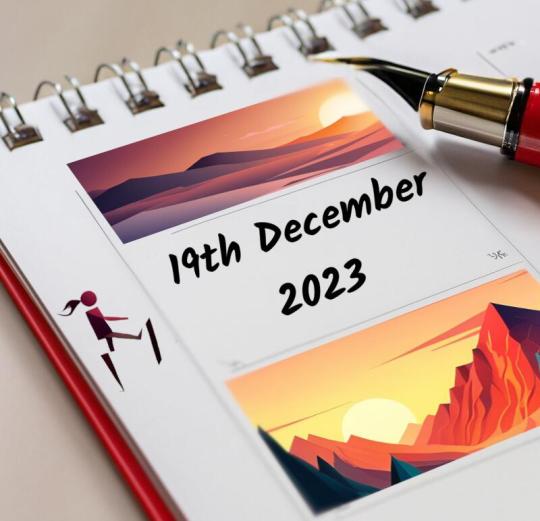
19th December 2022 🗓️ : Event - Argentina
Argentina won the 2022 World Cup.
"Argentina (Spanish pronunciation: [aɾxenˈtina] ), officially the Argentine Republic (Spanish: República Argentina), is a country in the southern half of South America. Argentina covers an area of 2,780,400 km2 (1,073,500 sq mi), making it the second-largest country in South America after Brazil,..."

Image by See File history below for details.
19th December 2016 🗓️ : Event - Andrei Karlov
Andrei Karlov (pictured), Russia's ambassador to Turkey, was assassinated at an art gallery in Ankara.
"Andrei Gennadyevich Karlov (Russian: Андрей Геннадьевич Карлов; 4 February 1954 – 19 December 2016) was a Russian diplomat who served as the Russian ambassador to Turkey and earlier as the Russian ambassador to North Korea.On the evening of 19 December 2016, while speaking at an art gallery..."
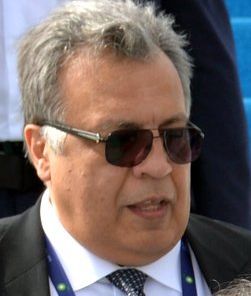
Image licensed under CC BY 4.0? by Пресс-служба Президента России
19th December 2013 🗓️ : Event - European Space Agency
The European Space Agency's spacecraft Gaia was launched with the goal of constructing the largest and most precise star catalogue ever made.
"The European Space Agency (ESA) is a 22-member intergovernmental body devoted to space exploration. With its headquarters in Paris and a staff of around 2,200 people globally as of 2018, ESA was founded in 1975. By 2023, it will have an annual budget of about €7.08 billion.ESA's space flight..."

Image licensed under CC BY-SA 3.0 igo? by European Space Agency
19th December 1973 🗓️ : Birth - Zulfiya Zabirova
Zulfiya Zabirova, Russian cyclist
"Zulfiya Khasanovna Zabirova (Зульфия Хасановна Забирова; born 19 December 1973) is a Russian professional cycle racer who won the gold medal in the time trial event in the 1996 Olympics and later, in 2002, won the World Time Trial Championship...."

Image licensed under CC BY-SA 3.0? by © James F. Perry
19th December 1923 🗓️ : Birth - Robert V. Bruce
Robert V. Bruce, American historian and author (d. 2008)
"Robert Vance Bruce (December 19, 1923 in Malden, Massachusetts – January 15, 2008 in Olympia, Washington) was an American historian specializing in the American Civil War, who won the 1988 Pulitzer Prize for History for his book The Launching of Modern American Science, 1846–1876 (1987). After..."
19th December 1820 🗓️ : Birth - Mary Livermore
Mary Livermore, American journalist and activist (d. 1905)
"Mary Livermore (born Mary Ashton Rice; December 19, 1820 – May 23, 1905) was an American journalist, abolitionist, and advocate of women's rights. Her printed volumes included: Thirty Years Too Late, first published in 1847 as a prize temperance tale, and republished in 1878; Pen Pictures; or,..."

Image by Linus Pierpont Brockett and Mary C. Vaughan
19th December 🗓️ : Holiday - Christian feast day: December 19 (Eastern Orthodox liturgics)
"December 18 - Eastern Orthodox liturgical calendar - December 20 All fixed commemorations below celebrated on January 1 by Orthodox Churches on the Old Calendar.For December 19th, Orthodox Churches on the Old Calendar commemorate the Saints listed on December 6...."

Image by njk92
0 notes
Text
Top 10 Greatest Portuguese Footballers of All Time
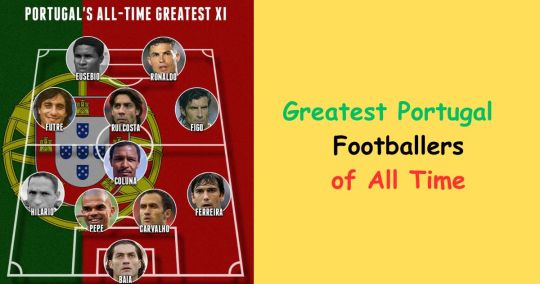
Cristiano Ronaldo:
Full Name: Cristiano Ronaldo dos Santos Aveiro
Date of Birth: February 5, 1985
Teams: Sporting CP, Real Madrid, Manchester United, Al Nassr
Position: Forward
Achievements: 5 Ballon d'Or awards, 4 European Golden Shoes, over 800 career goals, 32 trophies
Luis Figo:
Full Name: Luis Filipe Madeira Caeiro Figo
Date of Birth: November 4, 1972
Teams: Sporting CP, Barcelona, Real Madrid, Inter Milan
Position: Midfielder
Highlights: 1 Portuguese Cup, 4 La Liga titles, 3 Italian Super Cups, 4 Serie A titles
Eusebio:
Full Name: Eusébio da Silva Ferreira
Date of Birth: January 25, 1942
Died: January 5, 2014
Teams: Benfica
Position: Striker
Achievements: Top scorer at the 1966 FIFA World Cup, 733 goals in 745 matches
Mário Coluna:
Full Name: Mário Esteves Coluna
Date of Birth: August 6, 1935
Died: February 25, 2014
Teams: Benfica
Position: Midfielder
Achievements: 525 appearances, 127 goals for Benfica
Vitor Baia:
Full Name: Vítor Manuel Martins Baía
Date of Birth: October 15, 1969
Teams: Porto, Barcelona
Position: Goalkeeper
Achievements: 26 championships with Porto, played in two European Championships and 2002 FIFA World Cup
Paulo Futre:
Full Name: Paulo Jorge dos Santos Futre
Date of Birth: February 28, 1966
Teams: Sporting CP, Atletico Madrid, West Ham United
Position: Winger
Achievements: Spanish Cup winner, Portuguese Footballer of the Year in 1986 and 1987
Nani:
Full Name: Luís Carlos Almeida da Cunha
Date of Birth: November 17, 1986
Teams: Fenerbahce, Lazio, Valencia, Manchester United
Position: Winger
Achievements: UEFA Under-21 Championship, 112 appearances for the senior Portuguese team
Pepe:
Full Name: Kepler Laveran de Lima Ferreira
Date of Birth: February 26, 1983
Teams: Porto, Real Madrid
Position: Centre-back
Achievements: Two Primeira Liga titles, UEFA Champions League title, over 130 appearances for Portugal
Ricardo Carvalho:
Full Name: Ricardo Alberto Silveira de Carvalho
Date of Birth: May 18, 1978
Teams: Porto, Chelsea, Real Madrid, Monaco, Shanghai PSG
Position: Centre-back
Achievements: Instrumental in Porto's 2004 Champions League win, two Premier League titles with Chelsea
Deco:
Full Name: Anderson Luis de Souza
Date of Birth: August 27, 1977
Teams: Porto, Barcelona, Chelsea, Fluminense
Position: Midfielder
Achievements: UEFA Champions League winner with Porto, first player to win UEFA Midfielder of the Year award
#cristianoronaldo#luisfigo#eusebio#mariocoluna#vitorbaia#paulofutre#nani#pepe#ricardocarvalho#deco#footballer#football legends#soccer#goat#portugalfootball#footballlegends
0 notes
Text
World soccer has produced many friendly gamers up to now and even now. World soccer's historical past has witnessed immortal names. Who're they? Sporty Connect will present you with the TOP 10 finest soccer gamers of all time in the following article!
Top 10 Best Soccer Players of All Time | Sporty Connect Rank
Listed below are the top 10 soccer players of all time:
Who's the most effective soccer participant of all time
1. Diego Maradona
Diego Maradona is 1st title of the highest soccer participant of all time.
Maradona was born on October 30, 1960 in Lanus, Buenos Aires, Argentina. He began taking part in skilled soccer for the Argentinos Juniors crew at 16. After that, he rapidly became among the best soccer gamers ever seen.
As an attacking midfielder, Maradona began constructing a reputation for Argentina's high crew – the Boca Juniors crew.
Worldwide viewers noticed Maradona's excellent European expertise when he moved to Barcelona in 1982. He scored 22 targets in 36 video games for the Spanish membership.
However, Maradona's title reached new heights with the Italian facet Napoli, where he scored 88 targets in 188 appearances. The interval with Napoli (1984 – 1991) was additionally when Maradona flourished with the Argentina crew. The result was the World Cup championship in Mexico in 1986.
Diego Maradona is essentially the most basic image in soccer's historical past for the Argentine folks. The feat of main La Albiceleste to the throne in the 1986 World Cup has partly made up for that title.
Diego Maradona is the best soccer participant of all time.
Diego Maradona
2. Pele
Pele was born in 1940 in Brazil. He's well-known because he is the king of soccer on Earth. The achievements he achieved in his soccer profession are difficult for others to surpass.
Pele performs primarily for the Brazilian nationwide crew. He gained the World Cup with Brazil on three occasions in 1958, 1962, and 1970 respectively.
Pele is legendary to followers because of the king of soccer. FIFA additionally voted as the most effective participant of all time. Pele is an influential soccer participant in the Earth soccer village.
Pele
3. Lionel Messi
Lionel Messi is, without doubt, one of the best footballers of all time.
Lionel Messi was born in 1987. He's an Argentine. Lionel Messi formally left Barcelona after 21 years with this membership. Lionel Messi is, without a doubt, one of the finest gamers of all time. He's additionally among the best gamers on Earth in the meantime.
Lionel Messi gained the Ballon d'Or six times in 2009, 2010, 2011, 2012, 2015, and 2019. He additionally gained the European Golden Shoe on six occasions.
During the 2005 FIFA U20 World Cup, Lionel Messi obtained the title of Prime Scorer when he scored six targets in this event. Lionel Messi and the Argentina Olympic crew gained the gold medal at the Beijing Olympics in 2005.
Lionel Messi has won 9 La Liga titles in his profession.
4. Franz Beckenbauer
Franz Beckenbauer is a former German soccer participant and coach. Folks usually name him "der Kaiser." In German, it means emperor.
Franz Beckenbauer is well-known for his management and sublime model. He grew to become the best footballer in Germany and one of many best on the Earth.
He gained the Ballon d'Or twice, in 1972 and 1976. He's the one who created the well-known libero (sweeping defender) place when taking part in this place.
Franz Beckenbauer has contributed much to the German soccer crew as a participant, coach, and supervisor.
Franz Beckenbauer
5. Johan Cruyff
Johan Cruyff full title is Hendrik Johannes Cruijff. He's Dutch.
Johan Cruijff gained the Ballon d'Or thrice in 1971, 1973, and 1974. Folks knew him as "Saint Johan." Whether or not as a participant or a coach, he has made excellent contributions to the success of the Dutch crew.
The Dutch hero is the most effective soccer
participant of all time. Johan Cruijff can also be among the best footballers in world soccer's historical past. He was handed away in 2016 due to lung most cancers.
Johan Cruyff
6. Ronaldo Nazario
Folks name Ronaldo Luís Nazário de Lima “Alien”. He has gained the FIFA World Participant of the 12 Months award thrice, apart from additionally earning the Golden Ball award twice, in 1997 and 2002.
In 2007, Ronaldo Nazário was "honored" by the France Soccer Journal. He is, without a doubt, one of the high 11 best younger gamers in the historical past. In 2004 he was "named" in FIFA's 100 best gamers alive compiled by Pelé.
He performed for the Brazilian nationwide crew in 98 matches. He scored 62 targets and has become the second-highest scorer for the national team.
At the 1998 World Cup Ultimate, he obtained the Golden Ball for the event's finest participant. Ronaldo gained his second World Cup Ultimate in 2002. He scored twice within the ultimate and received the Golden Boot as the highest scorer.
Through the 2006 FIFA World Cup, Ronaldo scored his fifteenth World Cup objective, a World Cup file.
Ronaldo Nazario
7. Cristiano Ronaldo
Cristiano Ronaldo is a Portuguese soccer participant. Beforehand, he performed as a striker for Juventus membership within the Italian championship. He's additionally correctly often known as the Portugal nationwide soccer crew captain.
Cristiano Ronaldo is, without a doubt, one of the finest gamers on Earth. Ronaldo owned 5 European Golden Balls in 2008, 2013, 2014, 2016, and 2017.
He's additionally the proprietor of 4 European Golden Footwear. Each is data of a European participant, together with many different noble titles.
He has gained 32 titles in his profession. That features:
Seven nationwide championships.
5 UEFA Champions Leagues.
One UEFA European Championship.
One UEFA Nations League.
These achievements present no signal of stopping.
Cristiano Ronaldo
8. Zinedine Zidane
Zinedine Zidane, nicknamed "Zizou," is a gamer who has gained many league titles. He became a nationwide hero in France due to his efficiency with the national crew.
France gained the 1998 World Cup in opposition to Brazil thanks to 2 targets from Zidane within the ultimate. It was on this yr that Zinedine Zidane gained the European Golden Ball.
Zizou can also be well-known for his performances on the membership and worldwide degree. He gained the 2001-2002 UEFA Champions League with Actual Madrid and Juventus.
Zidane's achievements additionally embody successful the UEFA Cup in 2000, reaching the ultimate of the 2006 World Cup. Together with Pelé, Vava, and Paul Breitner, he is, without doubt, one of the sole gamers to attain in two completely different World Cups.
Zinedine Zidane
9. Michel Platini
Michel François Platini, born in 1955 in France, is a former participant of the Juventus membership and former soccer coach. From 2007-2016, he was President of the European Soccer Federation (UEFA Cup).
He gained the Ballon d'Or thrice in 1983, 1984, and 1985. Michel Platini was with the French crew that won the European Cup in 1984.
After retiring, Platini continued to guide the French crew as a coach. After that, he grew to become President of UEFA.
Michel Platini
10. Roberto Baggio
Roberto Baggio was "born" on February 18, 1967, in Caldogno, Veneto, Italy. He attends this checklist as one footballer of all time.
Baggio was with the Italian crew to attend 3 World Cups. He's the one Italian participant to attain in all three seasons.
Roberto Baggio was the Italian crew's finest participant in the 1994 World Cup. Baggio gained each world soccer's highest honors whereas taking part in. These are the European Golden Ball (1993) and the FIFA Participant (1993).
Roberto Baggio is a reputation with many imprints within the recreation's historical past.
Roberto Baggio
Ceaselessly Requested Questions
1. Who's the h
ighest scorer in World Cup's historical past?
The World Cup is soccer’s most significant event. Each participant's goal of representing their nation in this event. The historical past of the competitors has seen the most effective gamers on Earth showcase their skills. Listed below are the highest three scorers in the World Cup:
Miroslav Klose (Germany) – 16 targets.
Ronaldo Nazário (Brazil) – 15 targets.
Gerd Muller (West Germany) – 14 marks.
2. Who's the most effective Bald'Ord’Or participant ever?
The European Golden Ball has one other title, the Bald'Ord’Or. Because the European Golden Ball Award began, Lionel Messi is the primary participant in obtaining the Bald'Ord’Or award. And till now, Lionel Messi continues to be the one participant to win the European Golden Ball on six occasions.
3. Are there some other names with an excellent file of soccer's historical past?
So maYou'llu'll be able to be taught in regards to the gamers beneath Alfredo Di Stéfano, Mane Garrincha, Gerd Muller, Paolo Maldini, Ferenc Puskas, Franco Baresi, Zico, George Greatest, Marco van Basten, Eusebio, Lev Yashin, Bayern Munich, and so forth.
4. Is Alfredo Di Stéfano a distinguished title on this checklist?
Alfredo Di Stefano can also be on the checklist of the most effective gamers of all time. Alfredo Di Stefano was from Barracas, Buenos Aires, Argentina. He was handed away on July 7, 2014, in Madrid, Spain.
Alfredo Di Stéfano is a Spanish-Colombian soccer participant of Argentine descent. His title comes from the Actual Madrid membership.
He gained a complete 12 championships in his South American profession. He earned the Bald'Ord’Or twice, in 1957, 1959.
Alfredo Di Stefano is undoubtedly one of the most excellent gamerssoccer'ser historical past.
5. Who's the most effective soccer participant ever to elevate five consecutive European Cups?
He's Alfredo Di Stéfano. It occurred in the Fifties.
Last Ideas
Sporty Connect has provided valuable details about the highest ten soccer gamers ever. You may rep, "who she's the best soccer participant of all t? "Me,” Proper?
For extra sports activity data, comply with us! We will replace data and sports activity data so that sports activity followers can discover the correct data essentially.
Thanks for studying!
#SportyConnect
0 notes
Text
Women’s volleyball has seen numerous teams achieve greatness over the decades, marked by their stellar performances in various international championships. Here’s a list of the top 20 women’s volleyball teams of all time, along with details of their top players and championships won:
1. **Brazil**
- **Top Players:** Fofão (Hélia Souza), Fabiana Claudino, Jaqueline Carvalho, Sheilla Castro
- **Championships:** Olympic Gold (2008, 2012), World Grand Prix (12 titles)
2. **United States**
- **Top Players:** Kerri Walsh Jennings, Misty May-Treanor (Beach), Logan Tom, Foluke Akinradewo
- **Championships:** Olympic Gold (2020), World Championship (2014), World Cup (2015)
3. **China**
- **Top Players:** Lang Ping, Zhu Ting, Feng Kun, Yang Fangxu
- **Championships:** Olympic Gold (1984, 2004, 2016), World Championship (1982, 1986), World Cup (5 titles)
4. **Cuba**
- **Top Players:** Mireya Luis, Regla Torres, Ana Fernández, Magaly Carvajal
- **Championships:** Olympic Gold (1992, 1996, 2000), World Championship (1978, 1994, 1998), World Cup (1989, 1991, 1995)
5. **Soviet Union/Russia**
- **Top Players:** Inna Ryskal, Lyudmila Buldakova, Gamova Ekaterina, Lyubov Sokolova
- **Championships:** Olympic Gold (1968, 1972, 1980), World Championship (1952, 1956, 1960, 1970, 1990), World Cup (1973, 1999)
6. **Japan**
- **Top Players:** Saori Kimura, Yoshie Takeshita, Yuko Arakida, Kumi Nakada
- **Championships:** Olympic Gold (1964, 1976), World Championship (1962, 1967, 1974), World Cup (1977)
7. **Italy**
- **Top Players:** Francesca Piccinini, Paola Egonu, Eleonora Lo Bianco, Cristina Chirichella
- **Championships:** World Championship (2002), European Championship (2007, 2009), World Cup (2007, 2011)
8. **South Korea**
- **Top Players:** Kim Yeon-koung, Lee Hyo-hee, Yang Hyo-jin
- **Championships:** Asian Championship (1967, 1975, 1979), Asian Games (1994)
9. **Serbia**
- **Top Players:** Maja Ognjenović, Tijana Bošković, Brankica Mihajlović
- **Championships:** World Championship (2018), European Championship (2011, 2017, 2019, 2021)
10. **Netherlands**
- **Top Players:** Manon Flier, Robin de Kruijf, Lonneke Slöetjes
- **Championships:** European Championship (1995, 2017), World Grand Prix (2007)
11. **Dominican Republic**
- **Top Players:** Bethania De La Cruz, Prisilla Rivera, Brenda Castillo
- **Championships:** Pan American Games (2003, 2019), NORCECA Championship (2009, 2019)
12. **Turkey**
- **Top Players:** Neslihan Demir, Eda Erdem, Meryem Boz
- **Championships:** European League (2005, 2014), Mediterranean Games (2005, 2009)
13. **Germany (East Germany/West Germany/Unified)**
- **Top Players:** Angelina Grün, Christiane Fürst, Margareta Kozuch
- **Championships:** European Championship (1983, 1987), World Grand Prix (2002)
14. **Poland**
- **Top Players:** Malgorzata Glinka, Katarzyna Skowrońska, Dorota Świeniewicz
- **Championships:** European Championship (2003, 2005), World Championship (1952, 1956 - Bronze)
15. **Thailand**
- **Top Players:** Wilavan Apinyapong, Pleumjit Thinkaow, Nootsara Tomkom
- **Championships:** Asian Championship (2009, 2013), SEA Games (14 titles)
16. **Peru**
- **Top Players:** Cecilia Tait, Gabriela Pérez del Solar, Natalia Málaga
- **Championships:** South American Championship (12 titles), Pan American Games (1967), Olympic Silver (1988)
17. **Argentina**
- **Top Players:** Yamila Nizetich, Emilce Sosa, Leticia Boscacci
- **Championships:** Pan American Cup (2008, 2019), South American Championship (1997 - Silver, 1999 - Silver)
18. **Puerto Rico**
- **Top Players:** Aury Cruz, Karina Ocasio, Daly Santana
- **Championships:** NORCECA Championship (2009 - Bronze, 2013 - Bronze), Pan American Cup (2009 - Silver)
19. **Bulgaria**
- **Top Players:** Antonina Zetova, Elitsa Vasileva, Eva Yaneva
- **Championships:** European Championship (1981 - Gold, 1979 - Silver), World Championship (1970 - Silver)
20. **Czech Republic/Czechoslovakia**
- **Top Players:** Milena Foltýnová, Eva Štípková, Helena Havelková
- **Championships:** European Championship (1955, 1958), World Championship (1952 - Silver, 1956 - Silver)
These teams have left an indelible mark on the history of women’s volleyball through their exceptional performances and numerous championship titles. They have produced some of the sport’s most legendary players, contributing significantly to the game's global growth and popularity.
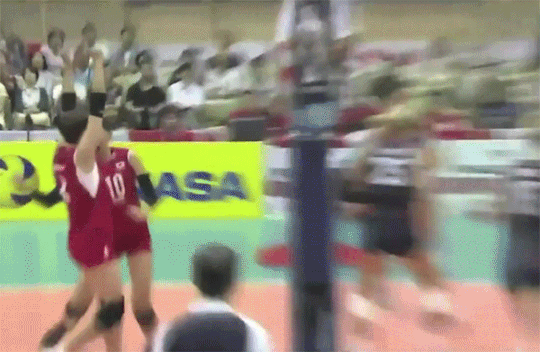
0 notes
Text
youtube
Camelia Voinea (ROU), FX, 1987 European Championship
3 notes
·
View notes
Text
Gerad Pique

This Biography is about one of the best Professional Cricketer of the world Gerad Pique including his Height, weight, Age & Other Detail…
Express info
Real Name
Gerard Piqué Bernabéu
Nickname
Príncipe Piqué, Piquenbauer, Geri
Profession
Spanish Professional Footballer
Age (as in 2023)
36 Years old
Physical Stats & More Info
Height
in centimeters- 193 cm
in meters- 1.93 m
in Feet Inches- 6’ 4”
Weight
in Kilograms- 87 kg
in Pounds- 192.8 lbs
Body Measurements
- Chest: 43 Inches
- Waist: 33 Inches
- Biceps: 14.5 Inches
Eye Colour
Blue
Hair Colour
Brown
Football Of Gerad Pique
Debut
Club Debut- In 2004 for Manchester United
International Debut- In 2009 for Spanish International Team
Jersey Number
3
Position
Centre-back
Coach/Mentor
Not Known
Records (main ones)
• Playing for Barcelona he helped the club win treble 2008–09 and 2014–15.
• He is one of the four players who have won UEFA Champions League two years in a row with two different team the others being Marcel Desailly, Paulo Sousa and Samuel Eto'o.
• Playing for Spain, he played a crucial role in the 2010 FIFA World Cup and UEFA Euro 2012.
Career Turning Point
• In 2006 U-19 European Championship in Poland, Piqué showed strong performance in defence, hitting the crossbar with a header, and also providing his team's second goal for striker Alberto Bueno.
• Gerard was named in the UEFA Team of Year of 2009.
Personal Life Of Gerad Pique
Date of Birth
2 February 1987
Birth Place
Barcelona, Spain
Zodiac sign/Sun sign
Aquarius
Nationality
Spanish
Hometown
Barcelona, Spain
School
Not Known
College
Not Known
Educational Qualifications
Not Known
Family
Father- Joan Piqué
Mother- Montserrat Bernabeu
Brother- Marc Piqué
Religion
Roman Catholic
Ethnicity
White Spanish
Hobbies
Watching NBA games and studying Economics.
Girls, Family & More Of Gerad Pique
Marital Status
Unmarried
Affairs/Girlfriends
Lisa Lazarus (2008)
Nuria Tomás (2009 - 2011)
Shakira (2010-present)
Wife
N/A
Children
Sons- Milan Piqué Mebarak and Sasha Piqué Mebarak
Money Factor Of Gerad Pique
Salary
$ 6.5 Million
Net Worth
$ 30 Million
This Biography written by www.welidot.com
Read the full article
0 notes
Text

Pallacanestro Brescia Scarpe Sportive
Brescia, city of Pallacanestro, known as the "King of Clubs". The team has been playing in the top division of Italian basketball since 1929. The club's home court is the PalaBasket. Brescia has won a total number of 341 championships, including 5 Italian Cups (1946, 1948, 1949, 1951, 1955), 4 National Championships (1947, 1948, 1949, 1951) and 2 European Cups (1965, 1987).
0 notes